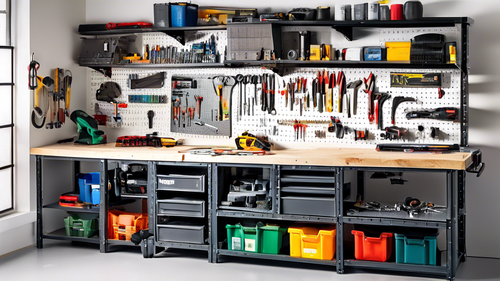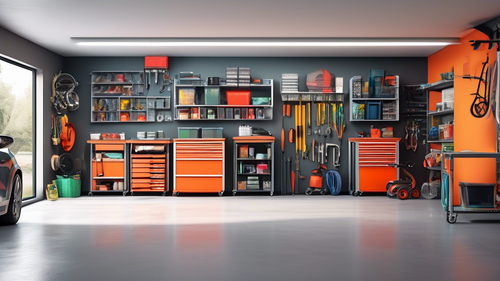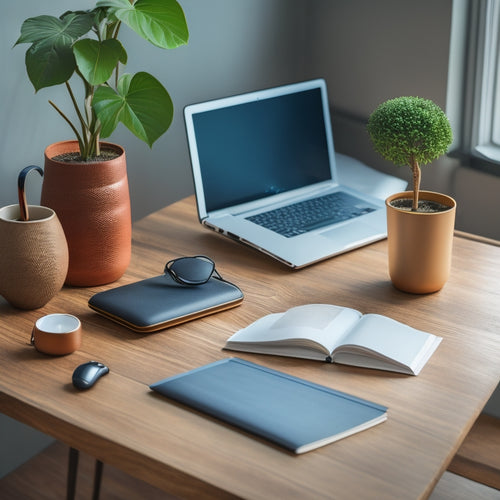
Effective Decluttering Strategies for Hoarders to Get Organized
Share
You're stuck in a cycle of clutter accumulation because you're not addressing the underlying emotional attachments and habits that drive your hoarding tendencies. Uncovering hidden patterns, acknowledging your triggers, and letting go of emotional items are crucial steps to facilitate decluttering. Surround yourself with a support network, including online communities and trusted friends, to stay motivated and accountable. Create a realistic decluttering schedule, celebrate small victories, and organize clutter hotspots first for immediate impact. By tackling these key areas, you'll be well on your way to breaking free from clutter's grasp - and there's even more to discover that can help you maintain a clutter-free life.
Key Takeaways
• Create a decluttering schedule with realistic goals and celebrate small victories to maintain motivation and momentum.
• Start with clutter hotspots, like high-traffic areas, to make an immediate impact and build confidence in your decluttering abilities.
• Sort items into categories, making decisions on what to keep and what to discard, to simplify the organization process.
• Implement storage solutions that are accessible, functional, and easy to maintain, reducing clutter and promoting long-term organization.
• Establish routines and regularly assess emotional attachment to items to prevent clutter accumulation and maintain a organized space.
Uncovering Hidden Clutter Patterns
As you start dealing with your clutter, begin by recognizing that hidden patterns and habits are often driving your accumulation of stuff, and it's vital to uncover these underlying motivations to make lasting changes. Identifying the triggers that lead you to hold onto items is key. Ask yourself, 'What emotions am I trying to fulfill or avoid by keeping this item?' Are you holding onto memories, fear of loss, or a sense of security? Addressing these emotions head-on will help you develop a deeper understanding of your behavior.
Recognizing hoarding tendencies in yourself can be challenging, but it's necessary to acknowledge them to move forward. Be honest with yourself - do you feel anxious about getting rid of items, even if they no longer serve a purpose? Do you feel overwhelmed by the thought of sorting through your belongings?
Seeking help from a mental health professional or a professional organizer can provide you with the guidance and support you need to overcome these obstacles. By acknowledging and addressing these underlying patterns, you'll be better equipped to develop healthier habits and maintain a clutter-free space.
Building a Support Network
You'll need a team of supportive people who understand your struggles to help you stay motivated and accountable throughout the decluttering process. Having a strong support network is essential in overcoming hoarding tendencies and achieving a clutter-free life.
| Support Options | Benefits |
|---|---|
| Online Communities | Connect with others who share similar struggles, access resources and expert advice |
| Trusted Friends and Family | Receive emotional support, encouragement, and help with decluttering tasks |
| Professional Organizers | Get personalized guidance, accountability, and hands-on assistance |
Find local, online communities for support and accountability. Share your progress and setbacks with trusted friends and family, and consider hiring a professional organizer if needed. Having a support network will help you stay on track, overcome obstacles, and celebrate your successes. Remember, you don't have to do this alone. By surrounding yourself with people who care and understand, you'll be more likely to achieve your decluttering goals and maintain a clutter-free life.
Creating a Decluttering Schedule
Now that you've got a support network in place, it's time to create a decluttering schedule that works for you.
You'll need to set daily decluttering goals, establish realistic timelines, and break tasks into manageable chunks to guarantee you're making steady progress.
Daily Decluttering Goals
Set a realistic daily decluttering goal for yourself, like dedicating 10-15 minutes each morning to tackling a specific area or task, to help you establish a consistent routine and make steady progress.
This daily commitment will help you build momentum and motivation, allowing you to make significant strides in your decluttering journey. Focus on achieving small victories each day, no matter how minor they may seem.
Celebrate the daily progress you make, whether it's clearing a single shelf or sorting through a small box. These small accomplishments will add up over time, giving you a sense of accomplishment and propelling you forward.
As you work towards your daily goals, remember that every step forward is a step away from clutter and chaos. By maintaining a consistent daily routine, you'll be amazed at how quickly your space transforms, and you'll feel more in control and empowered to tackle even the most challenging tasks.
Set Realistic Timelines
As you establish your daily decluttering routine, it's equally significant to create a realistic timeline for tackling larger areas or projects, breaking them down into manageable chunks that fit your schedule and energy levels.
This will help you make steady decluttering progress without feeling overwhelmed.
Effective time management is essential here, as it allows you to prioritize tasks, allocate sufficient time for each, and make the most of your decluttering sessions.
Break Tasks Into Chunks
To create a decluttering schedule that works for you, start by identifying the areas or tasks that need attention and dividing them into smaller, actionable chunks. This process, called chunking tasks, helps you focus on one task at a time, boosting your motivation and sense of accomplishment.
Break down larger tasks into manageable pieces, like sorting through a single shelf or clearing out a small drawer. Assign specific tasks to specific days or time slots, and prioritize tasks based on importance or urgency.
Effective time management is vital to staying on track. Set realistic goals for each task, and allocate sufficient time to complete them. Use a planner, app, or spreadsheet to track your progress, and celebrate your achievements along the way.
Progress tracking helps you see how far you've come, motivating you to continue. By breaking tasks into chunks and managing your time wisely, you'll make steady progress, stay motivated, and ultimately achieve your decluttering goals.
Letting Go of Emotional Items
You're likely to encounter emotional roadblocks when decluttering, particularly when faced with items that hold sentimental value or remind you of significant life events. It's natural to feel an emotional attachment to these items, but holding onto them can hinder your progress and perpetuate clutter. To overcome this, acknowledge the emotions tied to each item and accept that letting go doesn't erase the memories or significance.
When decluttering sentimental items, ask yourself: Does keeping this item truly bring me joy or serve a purpose? Would a photo or digital copy suffice instead of the physical item? Consider the 80/20 rule: 80% of the time, you likely only use or appreciate 20% of your belongings. Be honest with yourself, and let go of items that no longer serve you.
Organizing Clutter Hotspots First
Now that you've tackled the emotional hurdle of letting go, it's time to focus on the areas of your home that need the most attention, often referred to as clutter hotspots. These areas tend to accumulate clutter quickly, making them a great place to start your organizing journey.
Begin by prioritizing high-traffic areas like the bathroom and kitchen, where clutter can easily get out of hand. Focus on clearing off countertops, decluttering cabinets, and creating systems for daily essentials.
Next, tackle clutter-prone areas like your closet and garage. These spaces often become dumping grounds for items that don't have a designated home. Start by sorting items into categories, and then make decisions about what to keep, donate, or discard. Consider implementing systems like storage bins, shelves, or hooks to keep items organized and easily accessible.
Practicing Mindful Consumption Habits
As you work on decluttering your space, developing mindful consumption habits is crucial to prevent clutter from building up again.
You can start by being more intentional with your purchases, asking yourself if you truly require something before making a purchase.
Buy What You Need
Practicing mindful consumption habits starts with an essential mindset shift: buying what you need, not what you want, to break the cycle of clutter accumulation.
This means adopting a smart shopping approach, where you carefully consider each purchase before making it. Ask yourself, 'Do I really need this item, or do I just want it?' Be honest with yourself, and remember that your goal is to declutter, not accumulate more stuff.
When you focus on buying what you need, you'll find that you're more intentional with your purchases. You'll avoid buying duplicates or items that serve no purpose. You'll also reduce the likelihood of buying something on impulse, only to realize later that it's not useful or doesn't fit your needs.
Avoid Impulse Purchases
You'll find that adopting a 'wait 24 hours' rule helps you avoid making impulse purchases, allowing you to assess whether the item is something you truly need or just a want that'll likely end up cluttering your space. This simple strategy can greatly enhance your impulse control, leading to more mindful shopping habits.
By delaying your purchase, you'll have time to reflect on whether the item aligns with your goals and priorities. You might realize that you can live without it or find a more affordable alternative.
In addition to the 'wait 24 hours' rule, practicing mindful spending by setting a budget and tracking your expenses is crucial. This will help you identify areas where you can cut back and make more intentional purchasing decisions.
By implementing these budgeting tips, you'll be more likely to make thoughtful, needs-based purchases rather than emotional, wants-driven ones. Remember, every item you bring into your space should serve a purpose and bring value to your life.
Use Before Replacing
Three-quarters of the items you own are likely still in good condition, yet you're tempted to replace them with newer models or trendy alternatives. This mindset can lead to a never-ending cycle of consumption and clutter. Breaking free from this pattern is crucial by adopting a 'use before replacing' approach.
Before shopping, assess your needs. Ask yourself if you really need a new item or if what you already have can still serve the purpose. Be honest with yourself – do you truly require the latest gadget or can your current one still get the job done?
Reflect on your consumption habits and identify areas where you can cut back. Remember, every item you bring into your life takes up physical and mental space.
Maintaining Long-term Organization
By establishing accountability and setting realistic goals, you can create a routine that helps you stay on top of clutter and maintain long-term organization. This means implementing storage solutions that work for you, not against you.
Be honest with yourself about emotional attachments to certain items – if you haven't used it in a year, it's likely safe to let it go.
To ensure habit formation, start small and schedule dedicated time for organization and maintenance. Set a reminder on your calendar to tidy up for 10 minutes each day or dedicate an hour on the weekend to tackle a specific area. Consistency is key to developing a routine that sticks.
Effective time management is also vital – prioritize tasks, break them down into manageable chunks, and reward yourself for accomplishments. By doing so, you'll be more likely to maintain your hard-won organization and avoid slipping back into old habits.
Frequently Asked Questions
Can I Declutter if I Have a Physical Disability or Chronic Illness?
You can declutter despite physical disability or chronic illness by delegating tasks to able-bodied helpers, leveraging adaptive solutions like reach extenders or grabber tools, and pacing yourself to conserve energy.
How Do I Handle Clutter That Belongs to Family Members or Roommates?
You've likely wondered, "Can I really declutter someone else's stuff?" The truth is, you can't, but you can set family boundaries, acknowledging the emotional impact, and develop communication strategies for shared living to respectfully address clutter belonging to others.
What if I'm Overwhelmed and Don't Know Where to Start Decluttering?
"When you're overwhelmed, take a deep breath and acknowledge your feelings. Reach out for emotional support from a friend or family member, then break it down into small steps - start with one area or item, and celebrate each tiny win."
Can I Sell or Donate Items That Are Still in Good Condition?
You can definitely sell or donate items still in good condition, considering donation options like local charities or online platforms, and weighing resale opportunities on sites like eBay or Craigslist, while evaluating quality and ethical considerations.
How Often Should I Review and Adjust My Decluttering Progress?
"Rome wasn't built in a day," so pace yourself! Set aside time weekly to review your progress, ensuring accountability. Consistently reflect on your decluttering journey, making adjustments as needed, and celebrate small wins to stay motivated.
Related Posts
-

Garage Workbench Organization
Garage Workbench Organization: A Guide to Maximizing Space and Efficiency Are you tired of a cluttered and unorgan...
-

Maximize Your Garage Space: A Comprehensive Guide
Decluttering and organizing your garage can seem like a daunting task, but it's a worthwhile investment that will...
-

Mastering Digital Decluttering With 5 Essential Tools
You're tired of feeling overwhelmed by your digital clutter, and it's time to take control. To master digital declutt...


